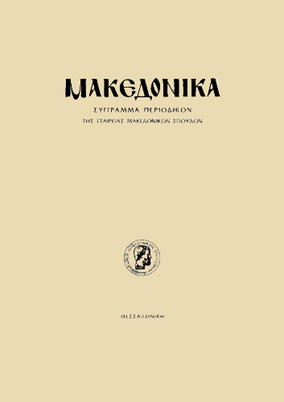Η χρονολόγηση του καθολικού της Μονής Κουτλουμουσίου
Part of : Μακεδονικά ; Vol.32, 2000, pages 443-482
Issue:
Pages:
443-482
Parallel Title:
The dating of the catholicon of the athonite monastery of Koutioumousiou
Section Title:
Articles
Abstract:
Opinions regarding the exact date of construction of the catholicon of the Monastery of Koutloumousiou vary: the latest dating that has been proposed is between the early and mid-16th century (1540), while the earliest is the first half of the 12th century. Faced with this wide divergence of views, it was necessary to investigate the available written evidence (archival sources, re ferences and inscriptions) together with the mural representations of the founders and particularly the architectural features of the church. Close examination of the written sources reveals that, of the references dating from the post-Byzantine era and the 16th century in particular, no mention is made of the foundation of a catholicon. In the praxeis (documents) which date from the 14th century and more specifically from the abbacy of Chariton, the need for and hope that the catholicon will be reconstructed —not merely enlarged: “...ανεγείρω τε ναόν μείζονα...”— is repeatedly expressed, and the other written and historical information we have relating to this subject indicates that the abbot’s wish was probably realized. As regards the architectural investigation of the church, if, first of all, we examine the characteristic features of the typology of 16th-century churches and of those built in the immediately preceding period, either on Mount Athos or outside, we find that these features are not present in the church in question. On the contrary, it displays certain basic characteristics typical of Palaeologan architecture. In all the comparisons that are made, the typology is examined not only from the point of view of the ground plan but also the entire plastic (stereometric) formation of the building. For it is particularly important to assess to what extent and how clearly the main compositional and structural principles of the cross-in-square type of church are expressed in the external appearance of the building: whether, for example, the cruciform core is elevated or not, whether the comer bays are subordinated to it, whether the faces are given a uniform appearance by setting undifferentiated blind arches side by side, etc. The dating of the building to the abbacy of Chariton is supported by structural, morphological and decorative features. In the appendix a number of observations are set out which show that the building is not the result of a Palaeologan conversion of a Middle Byzantine church (without choroi). According to this view, the sanctuary apse and the central dome were replaced, lateral apses (the choroi) and typikaria were added, and the supposedly narrow original narthex was extended to form the present-day liti. With regard to this theory, a brief note may be made of the following points:1. It is plausible that choroi should be added to the supposed original Middle Byzantine church. That the sanctuary apse should be replaced, however, more for the sake of making a formalistic adaptation, without essentially gaining any extra space, does not seem so plausible. 2. The choroi form an organic bond with the adjoining masonry and no vertical cracks have appeared where they are supposed to have been joined at a later date to the lateral walls, with which they display a structural continuity. The apses appear deeper than usual, probably to off set, as far as was possible, the compression of the central area of the church, which was due to the fact that built columns are less capable of supporting large vaults. 3. The liti (narthex) displays a typological, morphological and structural unity which befits the period we are dealing with (14th cent.). The east pilasters form an integral part of the west wall of the naos and divide the supposed original narthex into three equal parts, which is not usual for the Middle Byzantine period. Moreover, the blind arch (and corresponding window) which lies in what would have been the south face of this ‘original’ narthex is extremely off-centre in relation to the corresponding axis in the interior, which is also unusual for this period. The specific articulation of the existing arches can only be explained if the south wall of the liti is re garded as a single phase of construction. 4. The existence of built and not marble columns can be attributed to the adverse historical conditions of the second half of the 14th century. The later reinforcement of the supposedly thin original columns with a built outer casing would have been technically difficult if not impossible, and also unsafe in static (structural) terms.5. The specific system of proportions of the ground plan, which determines how close the columns should be placed to the lateral walls of the church, places the catholicon closer to that of the Monastery of Chelandari. The proportions of the dome also recall Palaeologan models.6. The ‘three-lobed’ window in the tympanum of the west arm of the cross, which cannot be attributed to a conversion, belongs to the type of window which occurs very frequently during the Palaeologan period.7. The general lack of marble architectural members in the composite windows, door-frames, cornices etc. is rather incompatible with a dating to the first half of the 12th century, and is also hard to explain if we accept a later extensive renovation.8. Evidence drawn from the form of roofing of the arms of the cross. Taking all the data that we have examined into account, we believe that the catholicon of the Monastery of Koutloumousiou was erected in the period 1370-1378 and does not constitute a conversion of a Middle Byzantine church.
Subject (LC):
Notes:
856:https://ejournals.epublishing.ekt.gr/index.php/makedonika/article/view/5740, DOI: https://doi.org/10.12681/makedonika.179
Electronic Resources:




